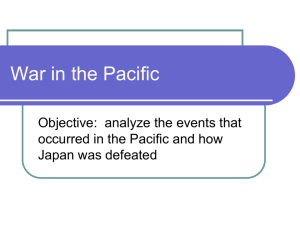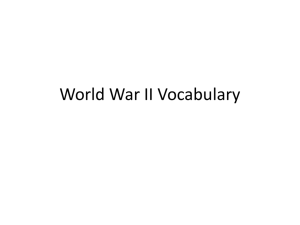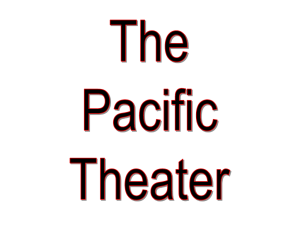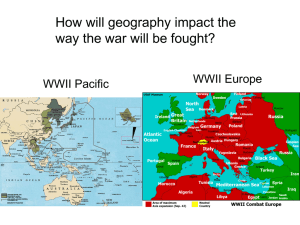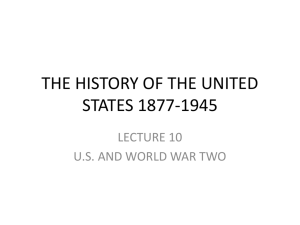The War in the Pacific
advertisement
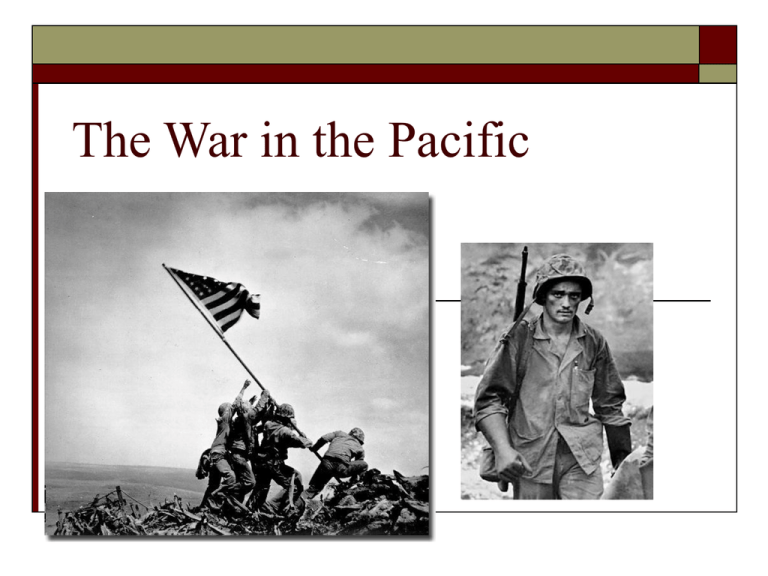
The War in the Pacific Japan and the United States Japanese Internment, 1942 Relocation & internment Executive Order 9066: 110,000 Japanese Americans Pacific coast "War Relocation Camps," Ability to designate "military areas" as "exclusion zones," Used to target all people of Japanese ancestry Korematsu v. United States : 1944, the US Supreme Court Case maintained legality of interment Grounds: need to protect against espionage outweighed individual rights Japan, Propaganda, & Dehumanizing The Savagery of the Pacific Life Magazine, May 22 1944 “Arizona war worker writes her Navy boyfriend a thank-you note for the Japanese skull he sent her. This skull of a Japanese soldier bears the inscription: ‘Here is a good Jap -- a dead one!’” Midway Island: June 4-7, 1942 The turning point in the Pacific Japanese plan Halts Japanese expansion in the Pacific. lure American ships into battle & permanently destroy the American war effort Intercepted battle plans Admiral Chester Nimitz Midway & Island Hopping Turning Point BUT not an immediate turn around for either nation. Japan maintained its superiority US still building up navy Island Hopping Campaign Avoid head on onslaught Attack strategically important islands Poorly defended but allow slow crawl towards Japan Bataan Death March Phillipines lost in 1942 75,000 American and Filipino prisoners of war marched 60 miles Death count: Impossible to determine…estimates6,00018,000 “I came out of Bataan and I shall return“ Douglass MacArthur US loses the Philippines but Douglas MacArthur promises a return… Battle of Guadalcanal, 1942-43 First major offensive launched against Japan Allies overwhelmed the outnumbered Japanese defenders First significant strategic victory for Allies Shifts the momentum of the Pacific Japanese had continued moving south in the Pacific. Guadalcanal stops this The Status Quo: 1944 Mid-1944 Japan controlled six million square miles Victory meant controlling the seas. “I have returned” -Douglas MacArthur Leyte Gulf: October, 1944 Japan lost 4 aircraft carriers, 400 planes and 16 additional surface ships. Neutralizes Japanese Navy US began bombarding outlying islands of Japan. B-29 bombers – long range bombers attack Japan Iwo Jima (February-March, 1945) First American attack on the Japanese home islands. Thus imperial soldiers defended their positions tenaciously. Americans made use of naval and air support Japan fortified Iwo Jima 5,000 pillboxes and fortified caves 13,000 yards of tunnels. A key area of defense was Mt.Suribachi Iwo Jima, Feb-March, 1945 Japan & US fought savagely Iwo Jima was 900 miles from Japan Japan had 21,000 men but only 1,000 taken prisoner, Americans 6,821 killed and nearly than 20,000 wounded. Allows US to bomb Japan, thereby reducing fuel consumption & flying time Raising the Flag Iwo Jima had one of the most famous images of the war Flag being raised on Mt. Suribachi Campaign on Tokyo March, 1945 – B29 Bombers attacked Tokyo Firestorm Tokyo mostly constructed of wood US dropped more than 2,000 tons of incendiary bombs More than 100,000 Tokyo residents were killed Japanese defenders on Okinawa aware of what happened in Tokyo Okinawa: The Last Battle, April 1945 April 1, 1945 1,300 US ships/50,000 men to invade Kamikazes 120,000 Japanese did not contest the landing. Sunk more than 20 US ships 1,000 kamikaze pilots died during battle Fighting ferocious. 110,000 Japanese defenders were killed. Civilians suffered losses between 70,000 and 160,000. United States lost 6,938 killed and 38 ships sunk. Okinawa Iwo Jima Midway Leyte Gulf Guadalcanal Potsdam Conference, July-August 1945 Participants Met to discuss how to punish Nazi Germany Also… ATOMIC WEAPONS: Truman informed both Churchill and Stalin of the A-Bomb Potsdam Declaration Message to Japan, threatening total destruction Told Japanese government to submit to unconditional surrender Winston Churchill -Harry Truman -Joseph Stalin Manhattan Project J. Robert Oppenheimer Gen. Leslie Groves Operation Olympic Invasion of Japan? Estimates 500,000 American soldiers killed Possible 1,000,000 casualties Or…Atomic Bomb Hiroshima & Nagasaki Why these cities? largely untouched by previous bombing Would allow assessment of weapon’s power AFTER Hiroshima & Little Boy August 6, 1945, at 8:15 AM Paul Tibbets & Enola Gay The Enola Gay dropped ‘Little Boy’ on Hiroshima Instantly kills an estimated 80,000 people. By the end of the year casualties to 90,000140,000 (due to radiation and other injury) 69% of the city's buildings were completely destroyed 7% severely damaged. HIROSHIMA BEFORE NAGASAKI BEFORE/AFTER Nagasaki & ‘Fat Man’ August 9, 1945 Nagasaki attacked at 11:02 a.m. Less killed by the second bomb: "Fat Man." Death toll totaled 73,884 74,909 injured Surrender Hirohito gave a recorded radio address to the nation on August 15. He declared a surrender, announcing to the Japanese populace the surrender of Japan. Official surrender signed on the USS Missouri on September 2, 1945. …THE END…for now…

